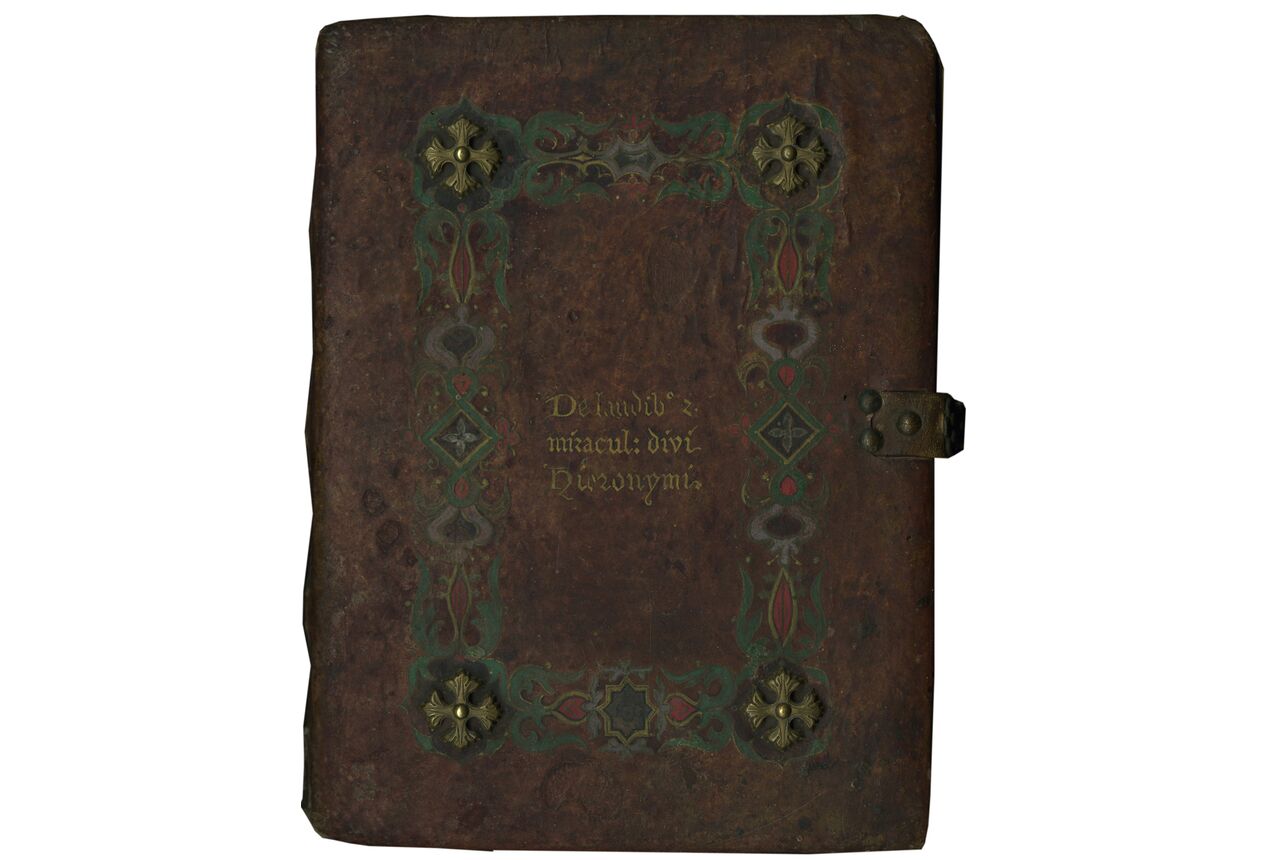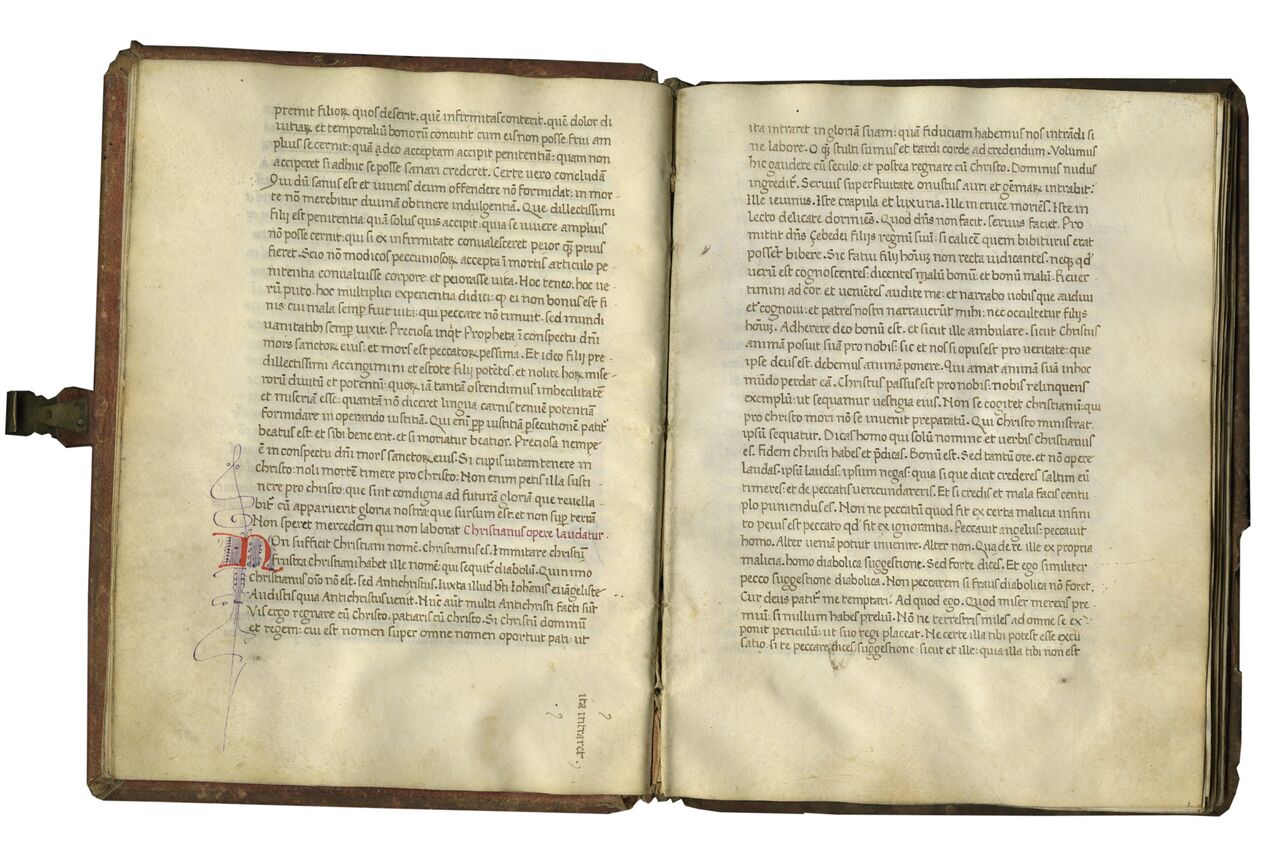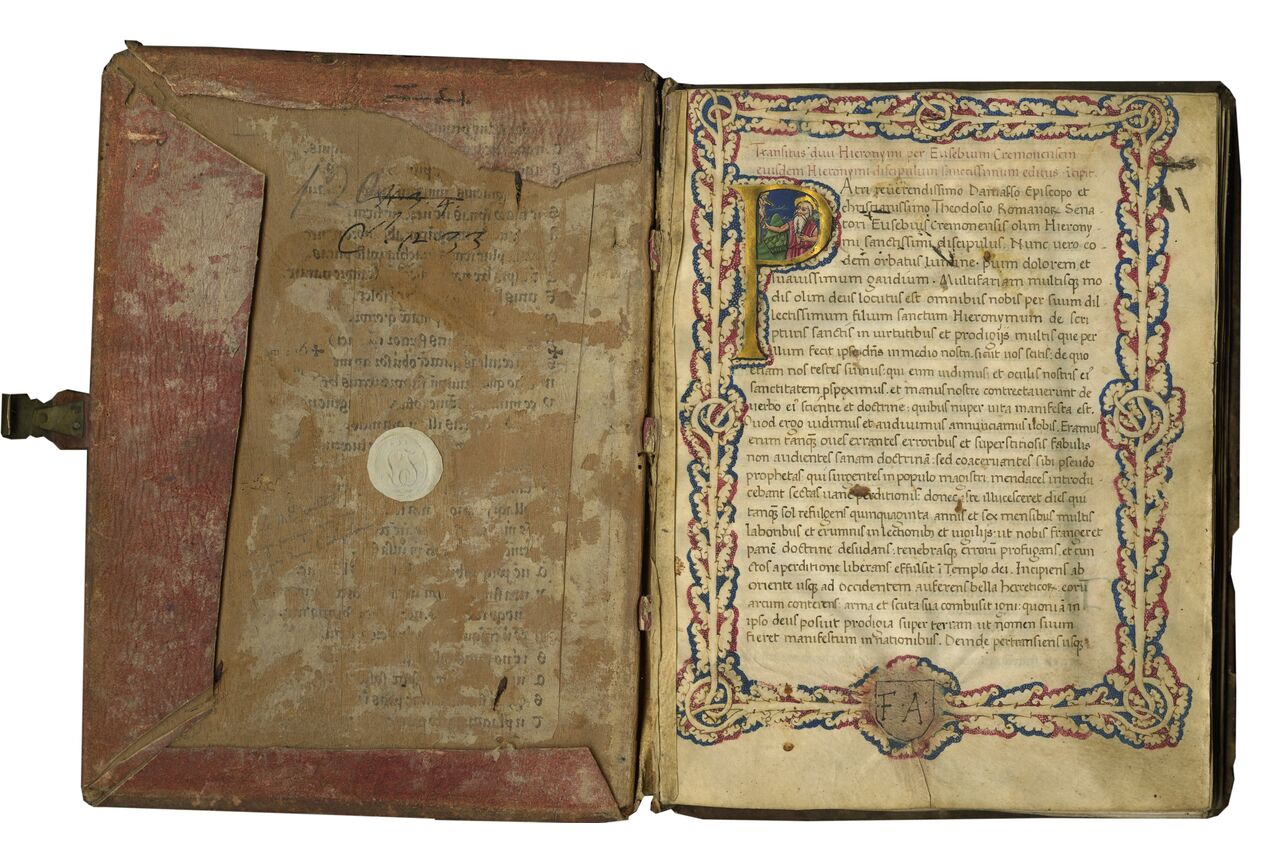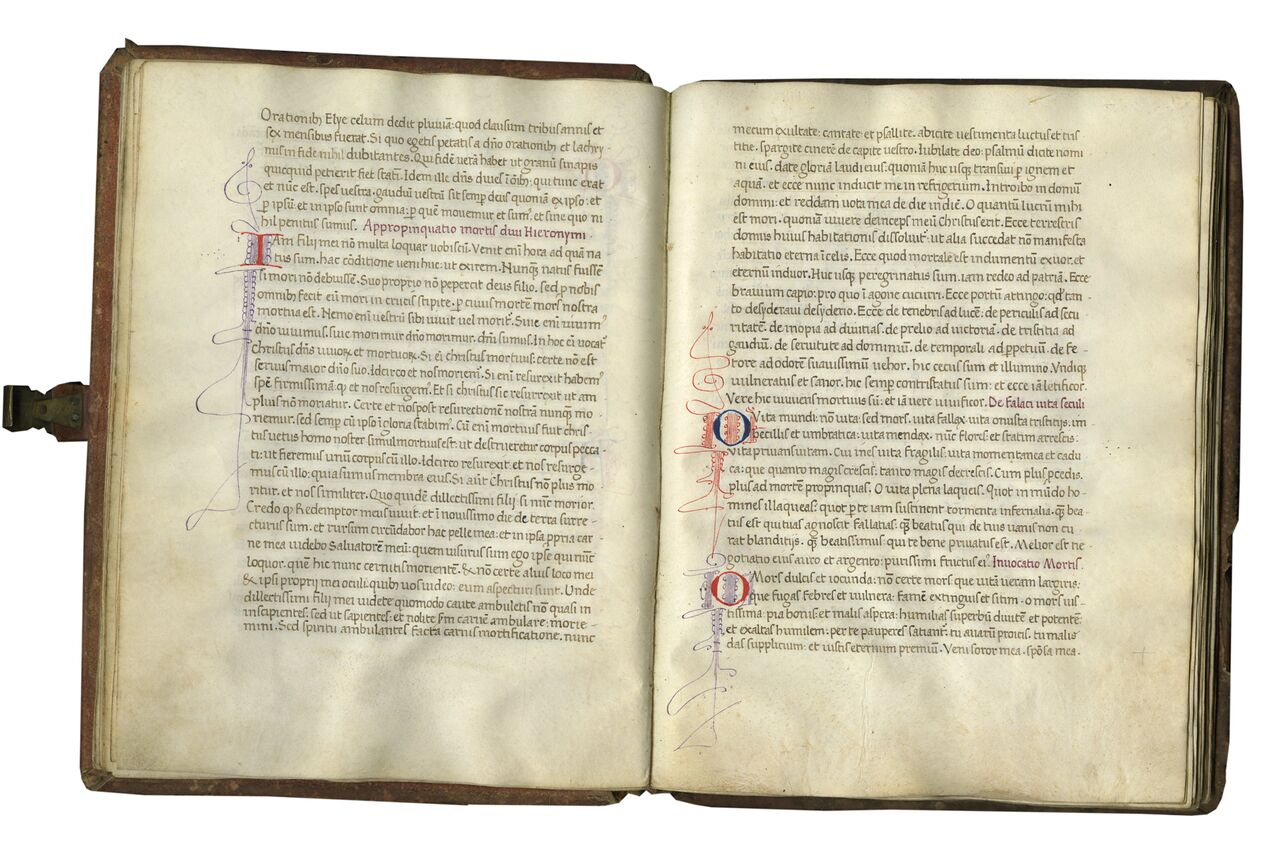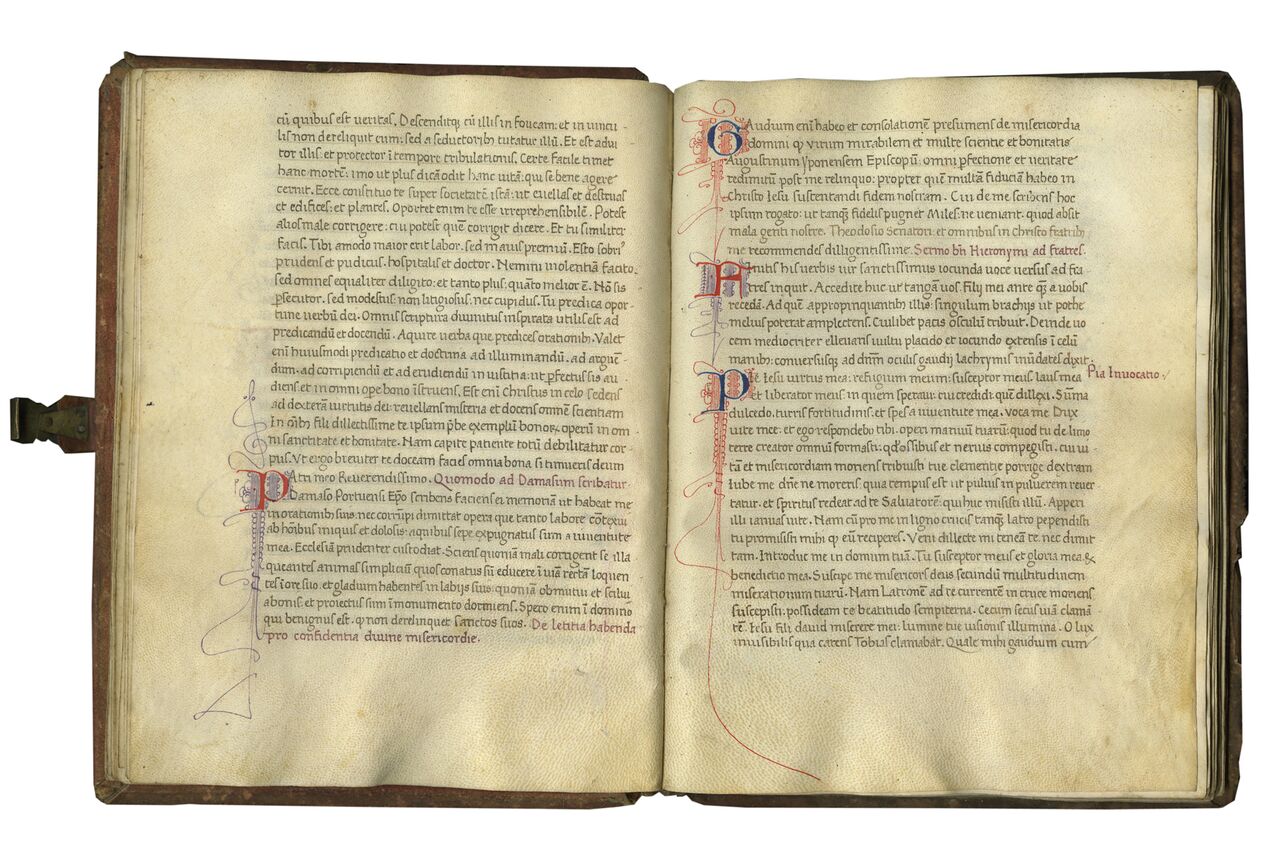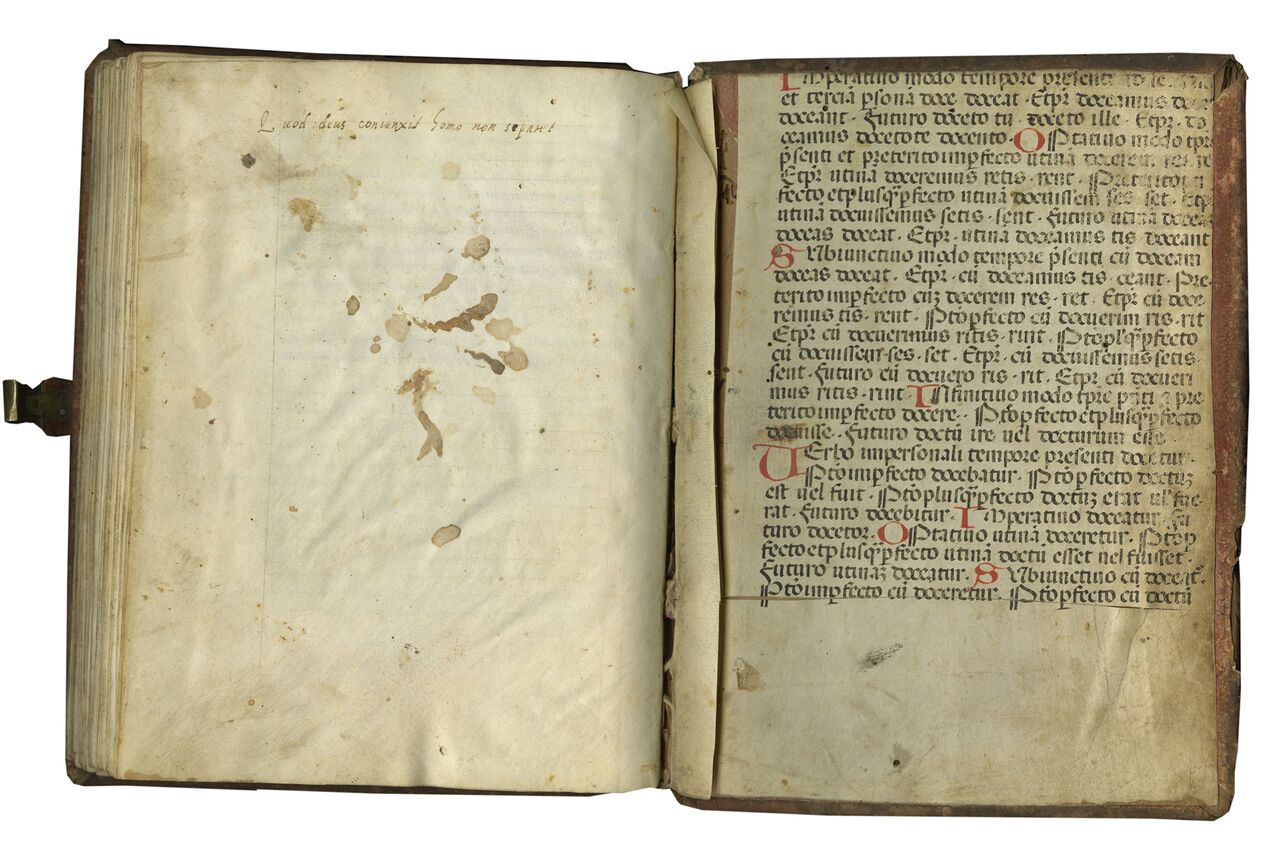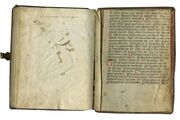70 folios on parchment (prepared in the manner of Southern Europe), early, probably original foliation in Arabic numerals, top outer corner recto in very pale red ink, now faded and missing on some folios, modern foliation in pencil top outer corner recto, complete, but with flyleaves removed, two stubs remain, back and front (collation i-vii10), a few remnants of leaf and quire signatures remain very bottom outer corner recto (mostly trimmed), flourished vertical catchwords copied between along the bounding lines in the lower margin, horizontal lines ruled very lightly in ink (?), single vertical bounding lines ruled in lead, prickings remain in top and bottom margins on some leaves, (justification 149-147 x 100-95 mm.), written on the top line in thirty long lines in a humanist minuscule, rubrics and paragraph marks in pale red, two-line alternately red and blue initials with contrasting pen flourishes in violet and red, two five-line blue initials, ff. 29v and 35, infilled and on a square ground of elaborate penwork; f. 64v, seven-line polished GOLD INITIAL with WHITE VINESTEM decoration extending along twenty lines of text and into the upper margin, infilled and edged in deep red and blue with numerous tiny silver dots, f. 1, five-line polished gold HISTORIATED INITIAL of St. Jerome, bearded, and dressed in red, standing before a Crucifix, with a hilly landscape in the background, on a with vinestem ground, extending into a FULL WHITE VINESTEM BORDER infilled and edged in deep and blue with tiny silver dots, erased coat of arms in lower margins, with modern (?) “F. A.”, in very good condition, top of the painted border, f. 1, very slightly trimmed, flyleaves removed (stubs remain), f. 1, darkened, some soiling throughout. Bound in early, almost certainly contemporary, reddish-brown leather over wooden boards, flat spine with three slightly raised bands, head and tail bands, clasp and catch fastening, closing front to back, with brass catch lettered “ave”, front cover decorated, most likely in the nineteenth century, with an attractive painted border in green orange and gray connecting four brass studs and the title, “De laudibus et miraculis divi Hieronymi”, with initials at the bottom, “F.C.”, back pastedown, leaf from Donatus’s Latin grammar, copied in Italy in the late fourteenth century, copied in a rounded gothic book hand, twenty-seven long lines remain, red initials, trimmed at the top and in the outer margin; front pastedown, offset script from removed pastedown visible in part, apparently from an text in Latin verse, copied in fourteenth-century Italy, , in sound condition, but spine with vertical crack and slight loss of the leather at the back, top of the spine, and over the lower band. Dimensions 203 x 153 mm.
The manuscript is a vivid witness to the importance of St. Jerome in fifteenth-century Italy, and includes the foundational texts for his cult. These texts were widely disseminated in both Latin and in vernacular translations and influenced the work of numerous writers and visual artists. Skillful script, handsome pen initials, and classic humanist white vine initials adorn the text, which begins with an historiated initial depicting an ascetic St. Jerome meditating before the Crucifixion.
Provenance
1. Copied in Northern Italy in the middle years of the fifteenth century, c. 1440-1470, as suggested by the evidence of the script and decoration; the penwork initials in particular seem to point to Northern Italy. The manuscript almost certainly once included the coat of arms of its original owner in the lower margin of the illuminated border on f. 1. They were unfortunately completely expunged and no trace remains.
2. Added in an elegant Italic script on the blank folio, f. 70v, “Quod deus coniunxit homo non separet” (That which God has joined, let no man separate).
3. Three sets of initials are inscribed, in three different hands, all possibly initials of owners: within the roundel on f. 1 a modern owner inscribed an outline of a shield in pen, and the initials “F. A.”; inside front cover, white embossed seal, with the initials “L. F.”; and on the front cover, as part of the added decoration, “R [?] C. [or G.?]”
Text
ff. 1-29, Transitus diui Hieronymi per Eusebium Cremonensem eiusdem Hieronymi discipulum sanctissimum editus incipit, “Patri reuerendissimo Damasso Episcopo et christianissimo Theodosio Romanorum senatori …”; f. 4v, Verba Hieronymi ad Eusebium, incipit, “Fili Eusebi cur istas inutiles effundis … et in futuro gaudia que tu iam possides adipisci. Amen”, Transitus diui Hieronymi per Eusebium Cremonensem editus. Feliciter finit”;
Ps.-Eusebius of Cremona’s letter to Bishop Damasus and the Roman senator Theodosius describing the death of Jerome; first published in Latin in Rome 1468 (GW 12421, Hain 8551) and many times after; BHL 3866; Cavallera, 1922-, II, 144-145; Migne, Patrologia Latina, vol. 22:239-282.
ff. 29v-34v, Libellus aureus diui Augustini de laudibus diui Hieronymi, incipit, “Gloriosissimi christianae fidei Athlete sancte matris Ecclesie lapis angularis in quo admodum …Non enim suo aliqualiter defraudatur desyderio, Vale”, Libellus aureus beati Augustini de visione et laudibus diui Hieronymi finit;
Ps.-Augustine’s letter to St. Cyril, bishop of Jerusalem, concerning the appearance of Jerome’s spirit to him, often referred to as the Epistola de magnificentiis Hieronymi ad Cyrillum; BHL 3867; published Migne, Patrologia Latina, vol. 22:282-289.
ff. 35-61, Liber cyrilli de miraculis diui Hieronymi ad beatum Augustinum init [sic], incipit, “Uenerabili viro Episcoporum eximio Augustino Hipponensi Presuli Cyrillus Hierosolymitanus Pontifex … Mei Augustine carissime in tuis orationibus memor esto. Vale Doctorum Lux”, Libellus elegans de Laudibus et Miraculis insuetis diui Hieronymi per Cyrillum Hierosolymitanum Episcopum editus felicter finit;
Ps.-Cyril of Jersalem’s Letter to Augustine concerning the miracles of Jerome; BHL 3868; printed Migne, Patrologia Latina, vol. 22:289-326.
These three letters purporting to be by three contemporaries of St. Jerome (c. 347-420), St. Eusebius of Cremona (d. 423), St. Augustine of Hippo (354-430), and Bishop Cyril of Jerusalem (c. 313-386) often circulated together. They were enormously popular and survive in more than four hundred manuscripts, most of which are fifteenth century (see Lambert, 1970, vol. III B no. 903; Rice, 1985, p. 219 says none date before 1300; against this, see Bauer, 1981, who states six are thirteenth-century, without listing the manuscripts), and were printed in thirty-six editions before 1501 (GW 3048, 9446-9481); they were translated into numerous vernacular languages, including Tuscan, Sicilian, German, Dutch, French, Spanish, Catalan, Danish and English (TM 605 on this site is an Italian translation); listed in BHL, 3866-3868; and printed Migne, Patrologia latina, vol. 22, cols. 239-326.
Modern scholars are in agreement that they were actually written much later than Jerome’s lifetime, although there has been some debate over exactly where and when. The evidence does seem to support the theory that they were probably written in Rome at the end of the thirteenth or early in the fourteenth century, in the circle of Santa Maria Maggiore; and internal evidence points to an author close to the Dominican Order (Rice, 1985, pp. 49-50, p. 63 and 218-19; see also Lanzoni, 1920, pp. 37-8). The remnants of Saint Jerome were believed to have been transferred in the late thirteenth century from the Holy Land to the “cappella del presepio” (the Chapel of the Holy Crib) in Santa Maria Maggiore in Rome. It is therefore logical to argue that there would have been in Rome, around Santa Maria Maggiore, the intellectual and spiritual impetus to compose works related to the saint’s death.
The first is a long letter describing Jerome’s last hours and death, purportedly from Jerome’s disciple and successor as Abbot of the Bethlehem monastery, Eusebius of Cremona, to Damasus, Bishop of Portus and Theodosius, a Roman senator. The second letter from Pseudo-Augustine to Pseudo-Cyril, Bishop of Jerusalem, is about Jerome’s magnigicentiae (i.e. his titles to glory and veneration). The third – Pseudo-Cyril’s reply to Pseudo-Augustine – describes Jerome’s miracles before and after his death. All three answered medieval readers’ avid curiosity about the details of Jerome’s death, and became the foundational texts for the cult of Jerome in fifteenth-century Italy. The process by which the Renaissance embraced Jerome, making him equal to all other saints, and superior to most, has been deftly told in Rice’s classic work, Saint Jerome in the Renaissance (Rice, 1985). Above all else, Jerome in these letters is a virtuosic ascetic and a powerful worker of miracles.
The impact of these letters extended beyond the written word; preachers used the letters in their sermons, artists represented them in their frescoes, paintings and manuscript illuminations. Their common purpose was to fulfill and nourish the wish for more details about the venerated saint, and to fill gaps in the known lives confirmed and magnified the saint, and contributed to his popularization.
ff. 61v-64, Diui Hieronymi vita per Eusebium Cremonensem edita incipit, “Hieronymus Eusebii viri nobilissimi filius ab oppido Studonis quod Dalmacie … Obiit autem prenominatus diuus Hieronymus circa Annum domini nostri Iesu christi cccxcvii. Finis”, Descriptio vite beatissime diui Hieronymi per sanctum Eusebium Cremonensem eius disipulum edita Finit;
Life of St. Jerome by an unknown author; BHL 3875; printed Migne, Patrologia latina, vol. 22, cols. 235-8; although it circulated often, as here, as a work by Eusebius of Cremona, it was probably by an Italian author writing in the twelfth century. The work was known to Vincent of Beauvais, writing in 1244, and to Jacobus de Voragine, writing in 1260, and survives in a manuscript, now in Rome, dating from the end of the twelfth or early thirteenth century. Drawing on Jerome’s epistles (real and spurious), as well as writings by Augustine, Gregory the Great, Damasus, and two earlier lives of St. Jerome, the author was not afraid to fabricate new details about the saint’s life. This is not one of the more well-known lives of Jerome, and is generally not mentioned in the scholarly literature.
ff. 64v-69v, Descriptio Inicii et finis vite felicissime beati Paulis Heremitarum Principis per diuum Hieronymum edita incipit, incipit, “Inter multos sepe dubitatum est a quo potissimum monachorum … Tunicam Pauli cum meritis eius quam Regum purpuram cum penis suis. Finis”, Aurea descriptio Initii et finis vite Pauli Heremitarum principis der diuum Hieronymum edita feliciter finit.”
Jerome, Vita Sancti Pauli (Life of St. Paul the Hermit), BHL 6596; printed, Migne, Patrologia latina, vol. 22, col. 17-28; critical edition, Degòrski, 1987.
This is the only work by St. Jerome included in this manuscript. It is one of his most important works, written in 374 or 375, which describes the life of St. Paul the first Hermit. It is a classic text, very widely read during the Middle Ages and Renaissance, which helped establish Jerome’s fame as an author of the early ascetic-monastic movement. In it, he addresses an educated Christian readership that was familiar with pagan literature. It demonstrates Jerome’s mastery of certain familiar narrative motifs and literary conventions, and was destined to significantly influence later hagiographic writing. Hundreds of copies survive, with 128 extant manuscripts of the Vita sancti Pauli dating earlier than the twelfth century, (Cherf, “The Latin Manuscript Tradition of the Vita Sancti Pauli”, in Oldfather, 1943, p. 65).
Back pastedown, incipit, “Imperativo modo tempore presenti ad secundam et terciam personam doce doceat … Preterito perfecto cum doctu//”
Donatus, Ars minor, apparently in the version printed in the late fifteenth century; see Schwenke, 1903, page 44, section 28.
Illustration
The small historiated initial shows Jerome, half-length, bearded and wearing a tunic, with a landscape in the background (interesting a rather green and fertile landscape instead of the rocky desert one might expect). Although in style rather naïve and primitive, the iconographical choice to show the ascetic Jerome contemplating the Crucifixion is an important one. Images of Jerome from the early Middle Ages showed him as a Doctor of the Church. The image of the penitent Jerome in the wilderness, however, dates from c. 1400 in Italy, and can be particularly associated with Hieronymite congregations in Tuscany. The Girolamini (Hieronymites, Ordo Sancti Hieronymi, abbreviated O.S.H.), is a common name for several congregations of hermits living according to the Rule of Saint Augustine, with supplementary regulations taken from the writings of Jerome, founded in the later fourteenth and fifteenth century. Their devotional practices were modelled on Jerome’s asceticism, including meditation on the Passion and sharing in Christ’s suffering.
Literature
Bauer, Erika. “Hieronymus-Briefe”, in Die deutsche Literatur des Mittelalters: Verfasserlexikon, ed. K. Ruh et. al., III, Berlin and New York, 1981, cols. 1233-1238.
[Bollandists]. Bibliotheca hagiographica latina: antiquae et mediae aetatis ediderunt Socii Bollandiani, Brussels, Société des bollandistes, 1898-1901 [cited here as BHL].
Cavallera, Ferdinand. Saint Jérôme; sa vie et son oeuvre, Louvain, and Paris, 1922- .
Coleiro, E. “St. Jerome’s Lives of the Hermits”, in Vigiliae christianae 11 (1947), pp. 161-178.
Degòrski, Remigiusz, ed. Edizione critica della “Vita Sancti Pauli Primi Eremitae” di Girolamo, Rome, Typis Pontificiae Universitatis Gregorianae, 1987.
Fros, Henricus. Bibliotheca hagiographica latina antiquae et mediae aetatis: novum supplementum, Brussels, 1986.
Lambert, Bernard. Bibliotheca Hieronymiana manuscripta. La tradition manuscrite des œuvres de Saint Jérôme, Steenbruges, Martinus Nijhoff, 1969-72.
Lanzoni, F. “La leggenda di S. Girolamo”, in Miscellanea geronimiana, ed. V. Vannutelli, Rome, 1920, pp. 37-38.
Linde, Cornelia. How to Correct the Sacra Scriptura: Textual Criticism of the Bible between the Twelfth and the Fifteenth Century, Oxford, 2012 (pp.49-57, cult of Jerome)
Oldfather, W.A. Studies in the Text Tradition of St. Jerome’s Vitae Patrum, Urbana, 1943.
Rice, E. Saint Jerome in the Renaissance, Baltimore, London, 1985.
Russo, Daniel. Saint Jérôme en Italie, Paris and Rome, 1987.
Paul Schwenke, Die Donat-und kalender-type : Nachtrag und übersicht ... mit einem abdruck des Donat-textes nach den ältesten ausgaben und mit 7.tafeln in lichtdruck, Veröffentlichungen der Gutenberg Gesellschaft, Mainz, 1903.
Vannutelli, V., ed. Miscellanea Geronimiana : scritti varii pubblicati nel 15 centenario dalla morte di San Girolamo, Rome, Tipografia Poliglotta Vaticana, 1920. See in particular F. Lanzoni, “La leggenda di S.Girolamo”, pp. 19-42, available online
https://archive.org/stream/miscellaneageron00vann#page/41/mode/1up
Online resources
Bibliotheca hagiographica latina manuscripta (analytical index to hagiographical manuscripts), On Jerome, see
http://bhlms.fltr.ucl.ac.be/Nquerysaintrubrique.cfm?code_dossier=Hieronymus%2001&rubrique=Hieronymus%20presb.
New Advent: English translation of Jerome’s Life of St. Paul the First Hermit
http://www.newadvent.org/fathers/3008.htm


